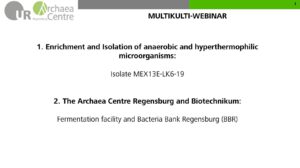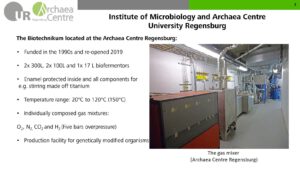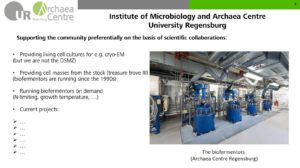What is hidden behind the term “Mucithermus cthulhu“?
This question was answered by Dr. Robert Reichelt from the Archaea Centre of the University of Regensburg, our spreaker at the MultiKulti webinar on 08.09.2022.
In his presentation, he first talked about the enrichment, isolation and characterization of anaerobic hyperthermophilic microorganisms. The focus was the newly discovered archaeon Mucithermus cthulhu, which belongs to a new genus within the family Desulfurococcaceae.
The isolate was detected in samples collected from hydrothermal vents in the Pacific Ocean and enriched under nitrogen atmosphere at a temperature of 100°C. The analysis of this hyperthermophilic organism revealed the presence of two mobile genetic elements in the genome and furthermore an interesting cell morphology. The cells possess tentacle-like protrusions which can be up to 6 µm long and 120 nm wide. The appendages are formed by vesicles organized in a bead-on-string structure and are surrounded by an extracellular matrix. Because of this morphology, the species was named after the tentacle-bearing “Great Old One” from H.P. Lovecraft’s story “The Call of Cthulhu” (1928). In the future, Mucithermus cthulhu could serve as an excellent and unique model system for virus-host interactions of archaea.
In the second part of his talk, Dr. Robert Reichelt gave us detailed insights into the equipment of the Archaea Centre Regensburg and the Biotechnikum, which allowed the successful isolation of this new species. The Archaea Centre combines facilities for enrichment, isolation and characterization, as well as for long-term storage of samples and microorganisms. Thus, it houses several ‘treasure troves’: 1) the original sample collection of a variety of marine habitats worldwide, 2) the Bacteria Bank, which to date stores approximately 2250 isolates and enrichments of bacterial and archaeal organisms in liquid nitrogen, and 3) the Biotechnikum, which is home to fermenters of up to 300 L volume. These fermenters are specially equipped and made of e.g. titanium to realize incubations at up to 120°C and with up to 5 bar overpressure. Some of the fermenters have been in continuous operation since 1990 and serve, among other things, to provide cell mass of various species for the scientific community.
The presentation was very informative for the microbiologists and the engineers of the MultiKulti team, as well as for numerous guests. This was also expressed in the lively discussion that followed. We extend a big “Thank you!” to Dr. Robert Reichelt for his presentation and the great exchange during the MultiKulti webinar!
The next webinar will take place on Thu, Nov 10, 2022 at 16:15. Interested guests are welcome to receive the access link via mail to info@multikultivierung.de.



